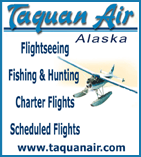 By ALEX deMARBAN Anchorage Daily News March 11, 2006
That's because the quaint fishing community in southwest Alaska, population 2,400, recently installed about 80 surveillance cameras at the port and around town, courtesy of a $202,000 Homeland Security grant. Anchorage has fewer than 40 cameras to protect its port. Dillingham Police Chief Richard Thompson, who came up with the idea of applying for the grant, said the cameras could stop terrorism in Southwest Alaska someday. More to the point, they may also put an end to the drinking, deaths and drug deals that go down at the port every summer when the town fills up with commercial fishermen.
If the system prevents even one death, Thompson said, "I don't care what's said about me." But some townsfolk are outraged. The only thing being captured by the cameras, they said, are their civil liberties. The white, plastic devices, clustered atop poles at the port or perched on four city buildings, feel like the glaring eyes of Big Brother. Some, with dual lenses for different lighting conditions, even resemble storm trooper helmets from Star Wars. "I think it's an invasion of privacy," said Freeman Roberts, a barge captain. "The government shouldn't be in the business of looking at people." A quiet city like Dillingham, without a single street light and more wildlife than humans, doesn't need one camera for every 30 residents, Tim Smeekins said. "There are no jihadist sockeyes swimming into our bay, no militant moose, no bomb-bearing belugas," he said. He and others hope to put the question of removing the cameras on the ballot this fall. More than 200 area residents have signed an informal petition demanding the cameras come down, Smeekins said. The German-made, Mobotix cameras are part of a national battle that pits the privacy rights of individuals against government intrusion as it tries to make America safe in the post-9/11 world. Critics also raise ongoing questions about the massive amount of money gushing from the Department of Homeland Security: $2.5 billion in grants last year alone. Opponents complain that money has been poorly spent, often on states with small populations and little security risk. Alaska, for example, trailed only Wyoming last year, receiving $24.83 per person, more than three times the per-capita amount spent in California. The federal windfall flushed $40 million into the state over the last three years, outfitting small remote communities with SWAT-team gear and high-tech hardware for land-and-sea rescues, chemical detection and criminal pursuit. North Pole, with about 1,600 residents, grabbed more than $700,000. That includes $11,000 for a hand-held thermal imager and $128,558 for 51 portable radios, according to the Division of Homeland Security and Emergency Management. Cordova, with about 2,300 residents, received more than $1 million. Some of the money paid for night-vision goggles, spotting scopes and tactical armor helmets. Akutan, an Aleutian Island village with 773 residents, won a $30,000 grant for a state-of-the-art rescue boat that can save drowning crewmen during the busy fishing seasons or chase ships suspected of terrorist activity, said city administrator Tammy Stromberg. "It's something we've needed for a long time," she said, adding that the city kicked in $20,000. Homeland Security grants aren't just for terrorism. The money can be used for law enforcement or natural disaster responses, said spokesman Jamie Littrell of the state's Homeland Security division. Opponents say those provisions dilute money that should be used to protect the country against terrorism. Another complaint: Each state is awarded a uniform chunk of money before an additional amount is given based on population. That's why Alaska has done so well. It's also why small communities in faraway places load up on top-of-the-line toys that may not protect the United States in another major terrorist strike, said Keith Ashdown, spokesman for Taxpayers for Common Sense in Washington, D.C. "The Department of Homeland Security has explained away massive expenditures on high-tech goodies for communities by saying we don't know where al-Qaida is going to hit next, but I'm in the camp that says you do need to take a risk-based funding strategy," he said. The department is moving in that direction, said Roberta Carney, the state division's fiscal manager. This year's grants will still provide a uniform, base amount to each state, but that amount will drop sharply. Population will still be a key factor, but a risk analysis and competitive bidding will also be part of the formula. As a result, the $13.3 million the state received last year could be almost halved. Or worse. "We're expecting $2 million to $7 million, but that's just my Ouija board," Carney said. Carney couldn't say how much has been spent to protect the trans-Alaska oil pipeline, which provides about 12 percent of U.S. oil. Scripps Howard News Service, http://www.shns.com Publish A Letter on SitNews Read Letters/Opinions
|
||


